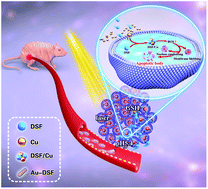Disulfiram-gold-nanorod integrate for effective tumor targeting and photothermal-chemical synergistic therapy†
Abstract
Herein, we successfully constructed a combination therapeutic nanoplatform with high tumor targeting for cancer treatment by integrating gold nanorods with disulfiram (denoted Au-DSF). The Au-DSF integrates possess a uniform length (70 nm), excellent photothermal conversion ability and a high DSF loading content (23.2%), and the loaded DSFs show glutathione-, acid-, and laser-responsive release properties. The Au-DSF integrates show significantly enhanced cellular uptake efficiency in breast cancer cells due to the ability of DSF to chelate to the intracellular copper (Cu) which is present at high concentrations. Furthermore, the Au-DSF exhibits improved circulation time (mean residence time = 28.4 h) and increased tumor accumulation (12.0%), due to the targeting of DSF to the abundant Cu ions at the tumor site. Moreover, the DSF/Cu complexes potently elevate reactive oxygen species, which effectively induce cancer cell apoptosis. In vivo experiments show that the Au-DSF integrates dramatically decrease tumor size via photothermal therapy and chemotherapy. Hematoxylin–eosin and TUNEL staining show that the Au-DSF integrates induce necrosis and apoptosis in cancer cells. The high therapeutic efficiency of the Au-DSF integrates for breast cancer is further demonstrated by the reduced elasticity seen in ultrasound elastography, and the absence of perfusion of the contrast agent in contrast-enhanced ultrasound imaging in tumors.



 Please wait while we load your content...
Please wait while we load your content...